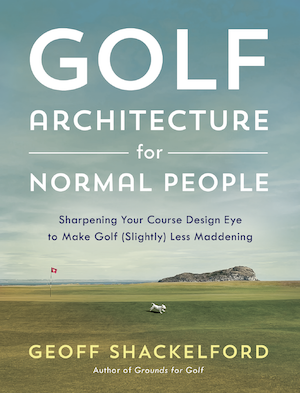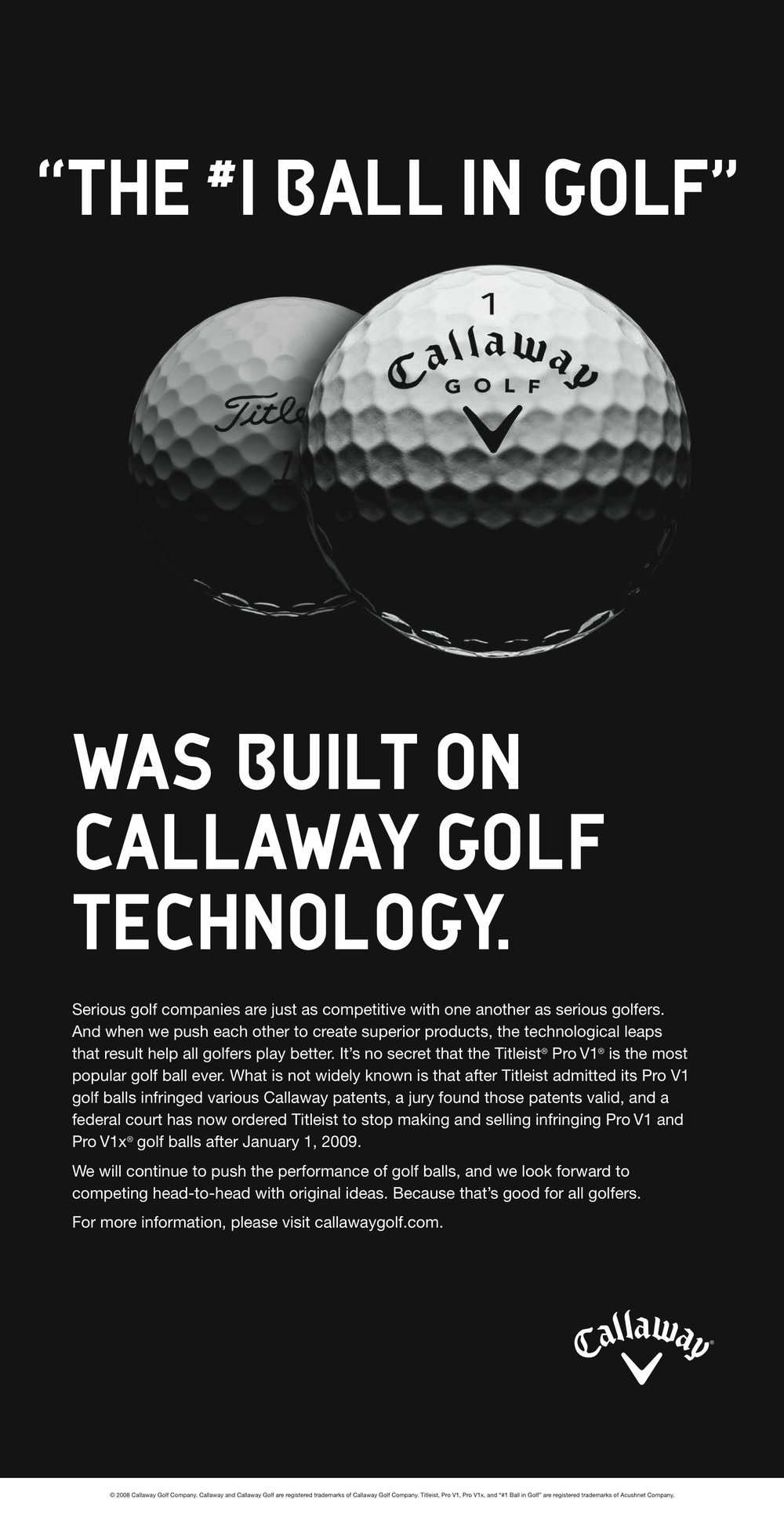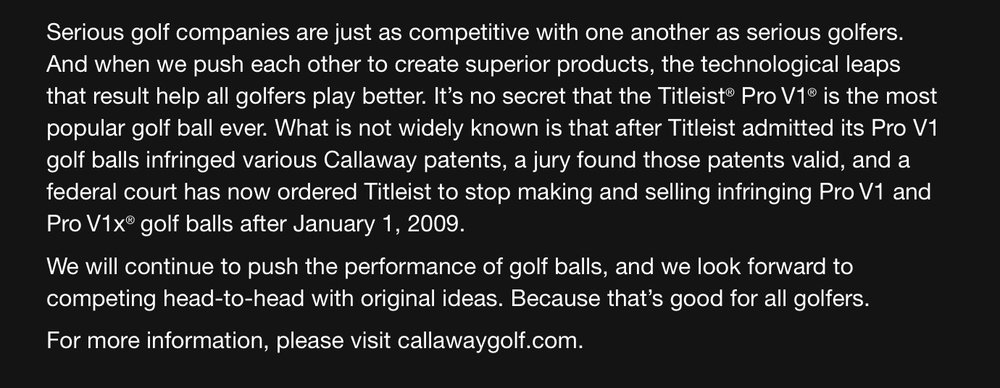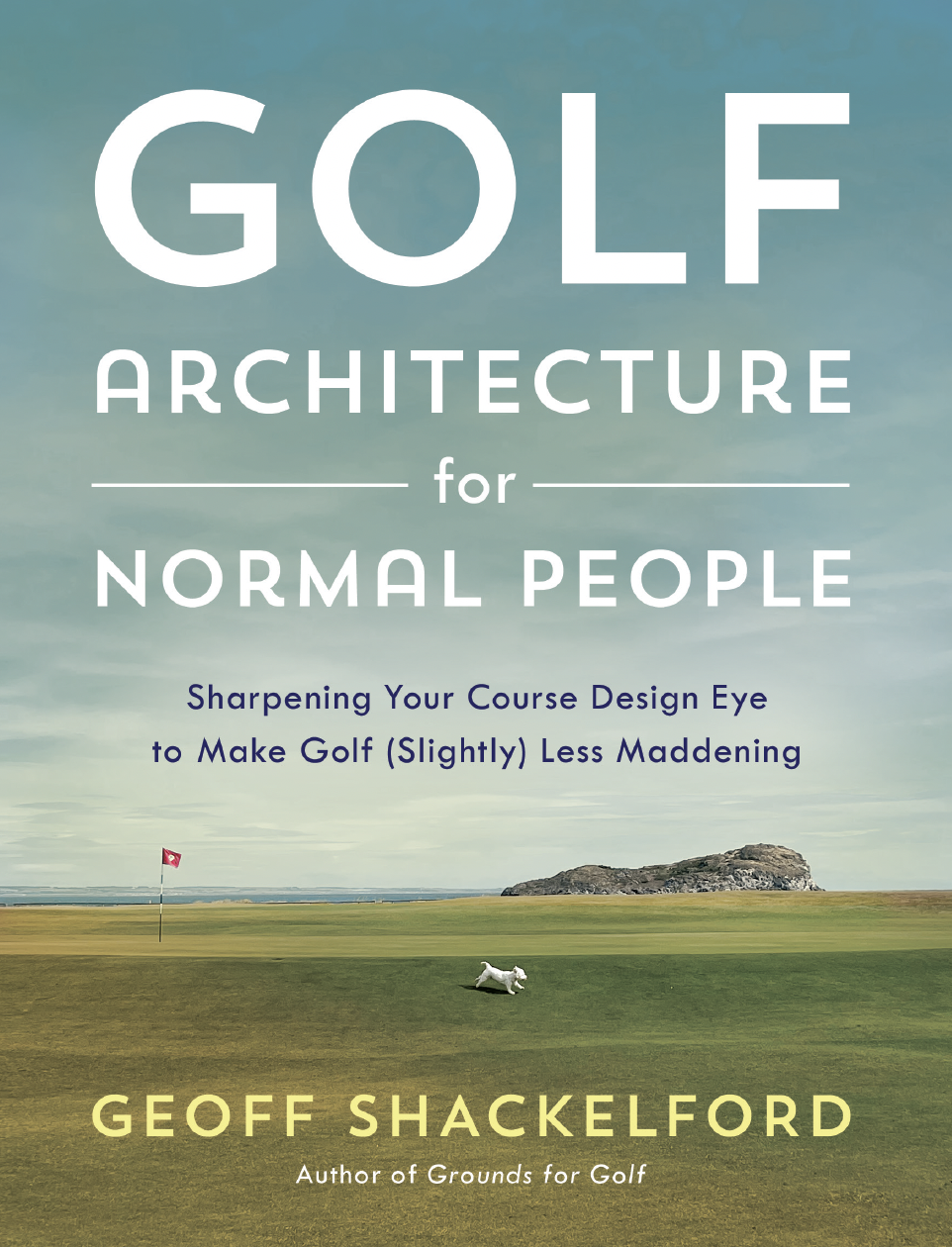“We have a reasonable understanding of the effect of the dimples and the way they change local air -flow distribution around the ball"
/You have to wonder if this is really the best use of university research dollars...
When you come to think of it that is the secret of most of the great holes all over the world. They all have some kind of a twist. C.B. MACDONALD

David Dawsey reports on his blog that Callaway and Titleist have settled a patent infringement suit related to drivers. It's great to see that these two are finally working out their differences and this should pave the way for that messy Pro V-1 entanglement to...wait, I'm sorry, what was that?
Oh...I spoke too soon. This went out to select scribblers today from Callaway:
Attached is a copy of an advertisement that will appear in select media outlets starting on Thursday, November 20, 2008.
The ad highlights our position regarding Callaway Golf’s heritage of technological innovation and our rigorous defense of our patents and technologies.
Thank you.
Michèle Szynal
Vice President, Public Relations
Callaway Golf
Well, Spalding's patents and technologies!
The ad, followed by the a close-up of the text.


If only they'd put all of this creative energy into original ideas like a classic course ball...now that would be good for golfers!
Wally, it was such a delight to see your name in my inbox this smokey Sunday morning, only to find a bullet point press release. Here I thought we were friends?
That's why I preferred this Op-Ed version from SouthCoastToday.com, which, if nothing else, proves that life is just fine in South Massachusetts if they can devote Op-Ed space to a patent spat.
Regardless, we want to assure our associates, customers, golfers and the community, that the injunction ruling will not have any impact on our ability to continue to manufacture, sell, ship and play Pro V1 golf balls now and in the future. This is due to the steps we took in September, well in advance of the court's decision, when we converted the production of existing Pro V1 model golf balls so they are outside the patents in question.
And who needs Lunesta when you can read news like this...
There will be no disruption in the supply of Pro V1 golf balls to golf shops around the world, or to the millions of golfers who play them. All versions of Pro V1 are legal and conform to USGA Rules and can be played with confidence. Further, Pro V1 golf balls will also be available to tour professionals and other competitive players through the remainder of the year or when their schedules resume in January 2009.
And you thought the USGA had done something...keep dreaming.
Reader Scott passed along this Wired.com piece by Chris Hardwick looking at the impact technology has had on bowling. The sport has never been easier to play but it doesn't seem to be translating to a healthy game. So they are turning back the clock just a bit for competition but altering ball specs.
It turns out that the sport's governing body, the United States Bowling Congress, is just as worried as I am. In Greendale, Wisconsin, at a climate-controlled facility that was almost certainly well-stocked with funnel cakes, the USBC deployed a 7-foot-tall robot named Harry. Armed with laser guides, hydraulics, and a mechanical arm, Harry's job was to bowl with the precision of a machine. As an engineer controlled release points, axis tilt, speed, and rotation, 23 sensors along the lane measured things like position and velocity. The goal, according to the USBC, was "to strike a better balance between player skill and technology." I am pretty sure the "strike" pun was intended.
The results, released earlier this year, were undeniable: Bowling ball composition had to be reined in. Starting in April 2009, precise limits will be set on how porous a competition ball's cover stock can be, standardizing how it adheres to the lane. Technology will be hobbled for the sake of the game.
As a purist of the sport, I'm grateful for the change. We should have to earn our marks the way our daddies (or, at least, mine) did: with hard rubber balls on wood, a hot lamp over the scoring table burning our hands and faces, and watered-down American beer lubricating each frame until we go home smelling like an ashtray in a chemical plant. "Keep yer got-damn science off mah balls!" we'll cry, and life will be good and pure and true.
With Seve on his mind and in his heart, John Huggan files his typically impassioned plea for a return of shotmaking. Though I think he was kind to the tours with this statement:
Of course, the unspoken realisation that card-and-pencil golf is inherently dull – stroke play only becomes watchable when it is magically transformed into match play on Sunday afternoons – is the biggest motivation behind the so-far failed Fed-Ex Cup series and the European Tour's new-fangled 'Race for Dubai' that will start in China next month.And...
And while the thoughts of golfers the world over are with Ballesteros as he lies in a Madrid hospital following surgery to remove a brain tumour, the most exciting golfer in living memory is just one who has expressed fears for the future of the game he loves.
"I see good swings and good players," said Seve. "But nothing that really keeps me watching television for a long time.
"Everybody has been equalised by the new clubs, the long putter, more loft on wedges. Something has to be done with the rules, otherwise golf will become more power than anything else."
He is right, of course. Until some imagination and flair is consistently injected into the presentation of the golf courses used for professional events – the recent Ryder Cup at Valhalla was a perfect example of how even a mediocre course set up properly can allow top players at least a chance to express themselves – then we are doomed to watch even the most creative individuals hacking out of long grass that exists only because of the aforementioned ball.
Before the Ryder Cup news takes over, let's not forget the grooves. In last week's Golf World, Mike Stachura raised some interesting questions about the validity of the rule change for 2010.
Second, if several popular irons already in use on the PGA Tour are said by their manufacturers to have groove patterns that already conform to the new rule (Titleist, Cobra, Adams and Ping have irons that may meet the new requirements), how much will the rule alter performance? And if the answer turns out to be not all that much, what is the USGA's next move?It starts with a b and ends with an l and would have been much easier to change.
I do believe that Adam Scott has been playing conforming grooves all year, and suspect many others have. If so, Stachura's point would seem to kill the case that a groove chance would reduce the amount of flogged drives.
Then there is manufacturer research that says the shot that might be affected most is the pinched wedge from the fairway. Does it not seem odd that a rule meant to restore the value for hitting the ball in the fairway might result in less effective shots from the short grass?
Oh great, another reason to narrow fairways. Just what the game needs.
John Huggan talks to Tom Watson about the state of game and in particular, the ball and equipment.
"I am very adamant that I think the ball should be brought back," he says, echoing the sentiments of many others of his generation, including Jack Nicklaus. "It goes too far. It also goes straighter and is therefore easier to control in a wind. But there are a lot of factors involved other than just pure distance. The rate at which the ball spins is important. They spin less these days and that is one reason they go farther. A higher spin rate would exaggerate misses and send the ball more off line than at present.
"The manufacturers got ahead of the USGA and the R&A. That's the bottom line. Those companies made balls that conform to rules that unfortunately allowed them to go too far. They're too easy to play. And that is true for all classes of player. Yes, they make less of a difference to the handicap golfer, but they still make a difference. Just not to the degree they do for the better leading professionals."
As you'd expect of a Stanford graduate – his fellow alumnus and close friend, Jim Vernon, is the current president of the USGA – Watson has solutions to the problem that has led to the vast majority of the current generation of players never knowing the joy that comes with perfectly shaping a shot into a stiff crosswind.
"When the ball goes as straight as it does now, you don't have to 'work' it from left-to-right or right-to-left; all you have to do is aim right at your target," continues Watson. "That takes a skill factor out of the game.
"The old guys had that skill factor, but the younger guys don't seem to have that same ability. Yes, they learn how to play that famous Tiger Woods 'stinger' – I saw a few of the kids using it at Birkdale last week – and that is a useful shot to have. But can they hit a stinger from right-to-left or left-to-right? That's what I want to see them doing, but right now I'm not.
"In defence of the young players, they have never had to learn a variety of shots. They have three wedges, for example. They have never had to add loft to their 56-degree wedge to make it play as if it has 60-degrees. I'm sure they understand how to hit the ball a little higher, but it's a lot easier to hit a high lofted shot with a 60-degree wedge than it is to hit one with only 56-degrees."
Tom Pernice livens up the lagging groove change discussion just in time for the best of British golf writing to give Peter Dawson a free pass when they lob Nerfballs at the Open Championship's R&A press conference!
Doug Ferguson reports on this and other Pernice venting:
"Why isn't the PGA Tour and Tim Finchem stepping to the plate and using our own rules?" Pernice said. "Tim's been against it all the time. We should have our own rules, and this way we could use V-grooves and everybody can have the same set, and driving the ball in the fairway might make a difference."
Or, make firm greens mean something? Well, we'll quibble over that later. You go Tom!
Here I thought Tom pulled Doug aside to share these rants and give Doug exclusive No. 495 for the year, but no, Pernice drops them in his post round press conference.
Special GWAA Rally Starter award goes to whoever teed Tom up...
Q. You've been on the TOUR policy board for a few years, and you've had some strong opinions about various issues, drug testing being one of them. Do you feel that's one of your roles on the TOUR, to be a guy who expresses himself on some of these subjects that maybe are not that easy to have a strong opinion on?
TOM PERNICE, JR.: Well, I think I'm just passionate about the game. I love the game and I love the TOUR. I think I don't want anything to not be as good as it can be for the game of golf and for the TOUR. I mean, yeah, I think there's several things that Commissioner Finchem has done a great job on, and I think there's been several things that he's very weak on.
I'm disappointed within the decision of the USGA and the R&A with the groove issue, for them to delay that. If they ever want to make driving part of the game, they need to go back to V-grooves.
But again, why isn't the PGA TOUR and Tim Finchem stepping to the plate and using our own rules? Tim's been against it all the time. We should have our own rules, and this way we could use V-grooves and everybody can have the same set, and driving the ball in the fairway might make a difference.
The WSJ's Tim Carroll profiles Dick Rugge and the USGA equipment testing, writing:
But for all the hand-wringing over all the booming tee shots on the Tour these days, the distance wars are actually waning. In the past couple of decades, the USGA has introduced limits on the lengths of club shafts (48 inches) and the size and volume of clubheads (no more than 5 inches square and 460 cubic centimeters), as well as the overall distance that a tested ball can fly (320 yards). At the time those rules came into effect, some of these parameters seemed generous, and there was room for equipment manufacturers to exploit them to make the ball go farther. But it's getting much harder to eke out more distance from a ball and club and stay within the rules.
At the same time, a number of Tour players are gaining a greater appreciation for the value of the control game and are beginning to emphasize finesse over distance. The Tour pro who most consistently hit the farthest off the tee last year, Bubba Watson, averaged 315.2 yards, but that was down from 319.6 yards in 2006. It was the first year-over-year decline in distance in a long time.
Carroll's piece serves as a nice table setter for E. Michael Johnson's questions in this week's Golf World about the need for a groove rule change.
The USGA points out that nearly half the shots hit from the rough find the green, and that's true (it's currently 48.64 percent). But what it doesn't say is that number rises to 74.68 percent from the fairway. In other words, over 14 holes (throw out the typical four par 3s), if a player hits it in the rough every hole he would hit seven greens on average. If he hits it in the fairway every hole he would hit 10.5.
Accuracy, in fact, is key to how players such as Hunter Mahan and Jim Furyk compete for titles. From the fairway Mahan makes birdie 21.28 percent of the time. From the rough it's 9.60 percent. Furyk goes under par 21.10 percent from the fairway and just 9.82 percent from the rough. The correlation between accuracy and success is zero? Perhaps for some of the bombers, but not for everyone.
Distance is not increasing. Playing from the rough is appreciably more difficult than playing from the fairway. Is it really necessary to do anything at this point? Just asking.
I used to believe Johnson's point made above was largely correct, but at this point a change in the groove rule would do two things (in theory): restore the importance of firmness and return the flier lie to its rightful place in the game. And (in theory) this would make deep hay lining fairways something we see less often in tournament golf, replaced by flier lie rough. That would be a great thing for the game, even if it means changing equipment.
Oh, and it establishes the precedent of a major equipment "rollback."
Jerry Potter does that informercial thing that only the USA Today has the cajones to try, this time with layering a monumental puff piece/suck up to advertisers with contributions from nearly everyone in the golf ball business.
See if you can spot the theme here:
Garcia sealed the victory with a wedge shot on the par-3 17th island hole when the ball stopped 4 feet from the cup. Garcia's skill certainly was a factor, but all players are finding that the current generation of golf balls is far better than anything in the past.
Next...
Statistics can be misleading, but victories aren't. Titleist, which dominates the PGA Tour in players, has 11 wins this year; Nike has six, including Trevor Immelman's win at The Masters.Callaway has two wins, but on the LPGA tour Lorena Ochoa and Annika Sorenstam have combined to give Callaway eight wins in 11 tournaments.
Clearly, the golf ball, whether a three-piece or a four-piece construction, is better than in past generations.
And finally...
As Nike's rep to the pro tours, Rick Nichols often pitches a new golf ball design to his father, Bobby Nichols, a former touring pro, who at 72 is all but retired from tournament golf."He always says, 'The ball is the same size as it used to be, isn't it? And, it's still round isn't it?' " Rick says.
The answer is yes to both questions, but today's golf ball is closer to perfect than at any time in the game's history.
And better than in past generations!
Come on Wally, even you had to find this one painful to read.
Beatnik and Gonzo over at GolfDigest.com pretty must shred to pieces the reported European Tour player questionnaire on grooves, then obtain the actual document and are largely validated in their skepticism. Still I was pleased to see they were asking players whether they thought the rule change would discourage flogging of tee shots.
 Very nice spot by reader Mark reading an Economist piece on Callaway CEO George Fellows, who apparently endorsed bifurcating the sport to save it.
Very nice spot by reader Mark reading an Economist piece on Callaway CEO George Fellows, who apparently endorsed bifurcating the sport to save it.
Another obvious strategy, though a more controversial one, is to make golf more “consumer-friendly”—meaning easier. Golf's rulemakers have tended to focus on maintaining the integrity of the game for the best players, which has made life tough for the rest. Callaway has to conform to a welter of arcane specifications: there are regulations about how far from the centre of the club a ball can be hit and still go straight, for example. These are intended to stop Tiger Woods shooting 30 under par, but also make the game less fun for less gifted players. Golf needs to “bifurcate” into a professional sport and a game for the masses, says Mr Fellows. One opportunity is to think outside the old 18-hole, four-hour box. Callaway has recently invested in TopGolf, a business that turns a driving range into a sort of dart board, where players aim at targets and scores are calculated with the help of radio transmitters in the balls.
It's amazing that it took a major company this long to endorse the concept. But at this point, other than grooves, is there really much that could be done to make equipment so much more user friendly that it would encourage growth?
Perhaps if Mr. Fellows had noted bifurcation could lead to less expensive equipment thanks to less emphasis on spending ridiculous marketing millions to convince people that they can get the same benefits from technology as the PGA Tour's best, then he'd be onto something.
Mr. Thomas, who in 1984 revised and strengthened a regulation specifically banning spring-like effect, believes the USGA should have stopped the new clubs with spring-like effect as soon as they were discovered, because they only created potential expense and problems for the game (such as the need for longer courses) and violated tradition. "The first paragraph of the first equipment regulation published by the USGA in 1909 prohibited clubs that 'contain any mechanical contrivance, such as a spring,' " Mr. Thomas noted. But instead, over his objections, the organization in 1998 merely set a limit on spring-like effect a little above the then-current levels. That decision, he believes, was primarily motivated by fear of lawsuits from clubmakers who were already marketing the clubs.
Combined with simultaneous advances in ball technology, swing-motion analysis, player training and agronomy, spring-like effect boosted the average drive on the PGA Tour an alarming 24 yards from 1995 to 2003. But in the last five years the distance creep has slowed (the average is actually down a bit so far this year) and Mr. Thomas is convinced current regulations will keep it capped.
 Thanks to reader Matthew for Sue Zesiger Callaway's review of the Segway X2 Golf. If the mere sight or thought of it doesn't horrify you, this should:
Thanks to reader Matthew for Sue Zesiger Callaway's review of the Segway X2 Golf. If the mere sight or thought of it doesn't horrify you, this should:Worst of all, if you're playing by the book you'll have to don a helmet, which adds to the already high dork quotient of golf. But considering I have been nicked by an errant ball once before, I suppose it's a style glitch I can live with.
GolfDigest.com's Bread and Grub look at some unfortunate shilling by Johnny Miller before launching into a discussion on U-grooves. You know, the thing the USGA and R&A can't agree on and which the PGA Tour won't get near.
A couple of things they wrote caught my eye. From Bread:
I find it difficult to believe the USGA will just walk away after three years of research without doing something. But I think that is exactly what they should do. Driving distance on tour this year is down three yards from the same time last year. Sure, it's a small sample, but I think everyone would agree that by year's end it's not likely we will see an increase of any substance, if any at all. And that would make it difficult to defend implementing a groove rollback, don't you think?And from Grub:
As for grooves, there's no question this issue, which appeared all but signed, sealed and delivered last fall, is about as near a resolution as me not wearing a seat belt anytime soon. Fact is, the best thing that could happen won't. Namely, the groove rule as proposed should be implemented on the PGA Tour for a five-year evaluation period. Only then will we see if it makes a difference.
So let's consider this for a moment. The PGA Tour is all about it's "product," right? And as was noted in my course setup story for Golf World, tournament director Mark Russell believes a groove change would allow for less rough on the tour and the return of the flier lie. Firm greens would also have more meaning. All of that would be more entertaining to watch and a better example for the game.
Yet the Commissioner keeps deferring (understandably) to the governing bodies because he knows what happened to Deane Beman when he raised a stink about grooves.
So how can the PGA Tour be convinced to adopt something along the lines of a tour-specific evaluation period? Thoughts?
Geoff Shackelford is a Senior Writer for Golfweek magazine, a weekly contributor to Golf Channel's Morning


Copyright © 2022, Geoff Shackelford. All rights reserved.